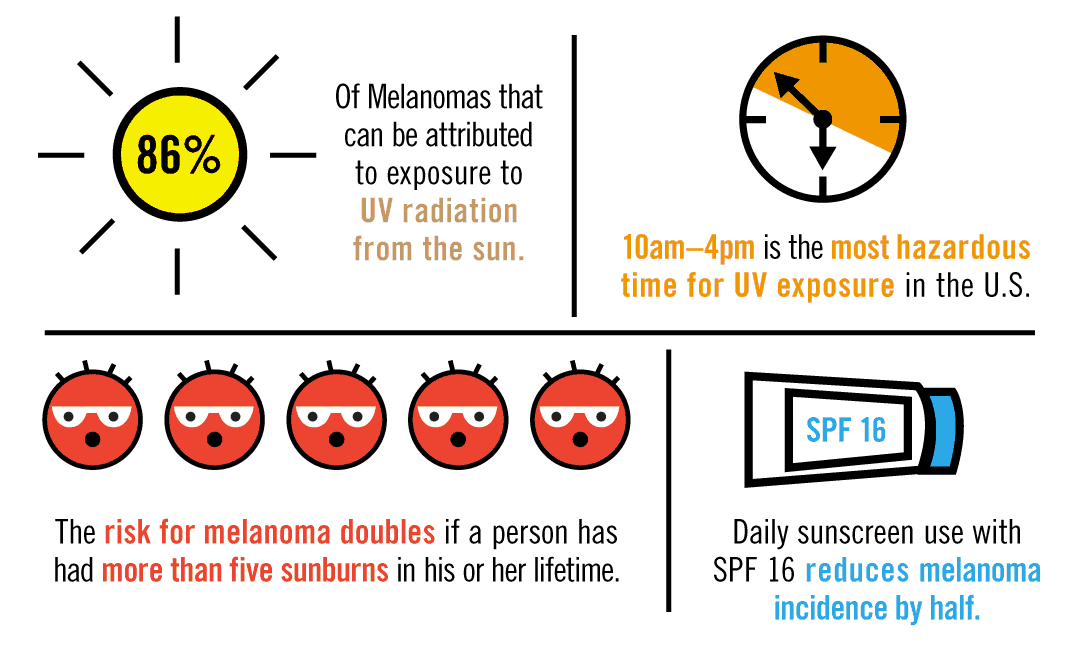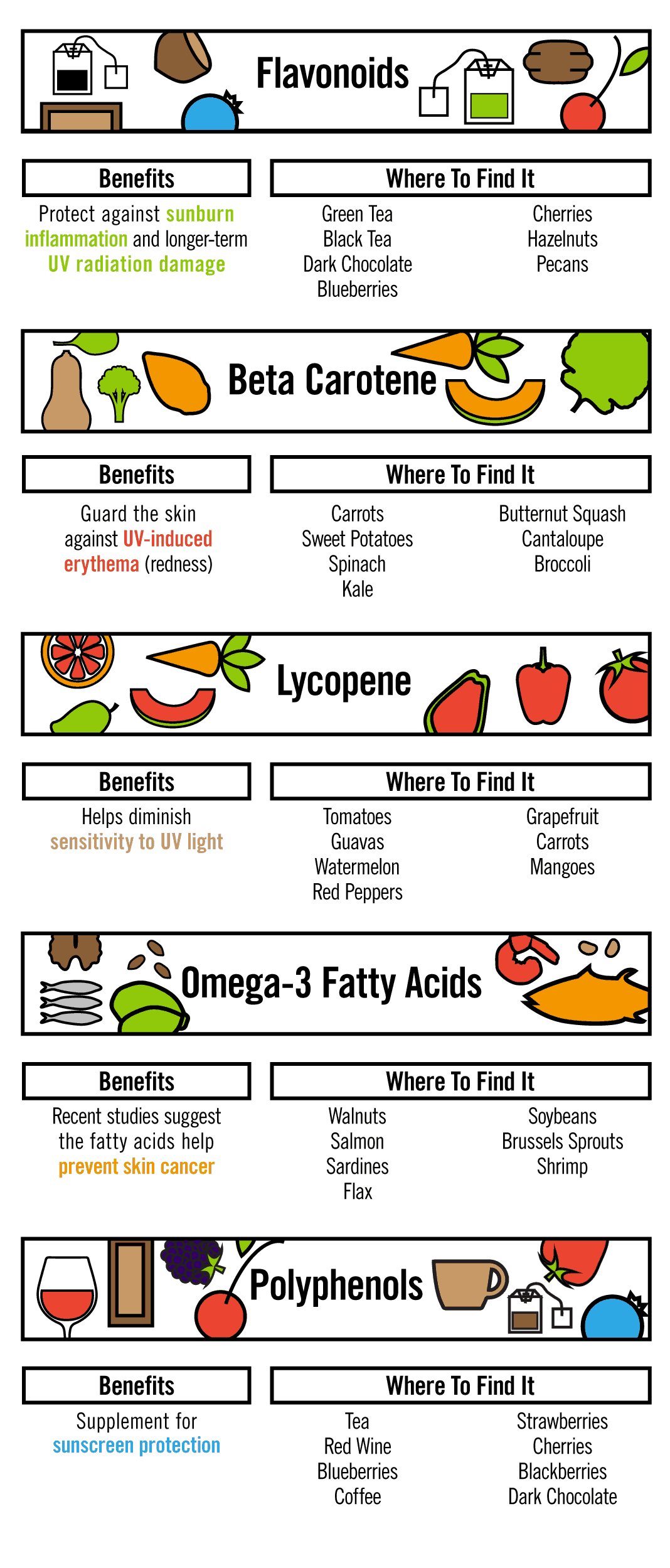Keep your skin beautiful and healthy in warm weather
For the majority of the country, summer equals lots of sunshine, extra time outdoors, and more exposed skin. While a healthy summer tan is still thought of as widely desirable by many in the U.S., any change in a person’s natural skin color is a sign of skin damage. Before you spend time in the garden, at the beach, or on a hike, find out the meaning behind SPF, how to properly apply sunscreen, and what to eat to protect skin from the inside out.
Skin Cancer: The Naked Truth
- Skin cancer is the most common form of cancer in the U.S. More than two million people are diagnosed with it annually.
- One in 50 people will be diagnosed with melanoma of the skin during their lifetime.
- About 86 percent of melanomas can be attributed to exposure to UV radiation from the sun.
- The risk for melanoma doubles if a person has had more than five sunburns in his or her lifetime.
- More than 170,000 cases of non-melanoma skin cancer in the U.S. each year are associated with indoor tanning.
- Avoiding sun in the first place is the only tried and true way to steer clear of melanoma.
- A ten-year study found daily use of an SPF 16 sunscreen reduced melanoma incidence by half.
- Between 10am and 4pm is the most hazardous for UV exposure in the continental U.S.
- Some medications such as antibiotics and antihistamines can increase a person’s sensitivity to the sun.
- Currently, there are 17 active ingredients approved by the FDA for use in sunscreens.
- Beyond cancer risk, UV radiation induces other harmful changes to the skin including thickening, wrinkle formation, and inflammation.
SPF to UV: The Letters You Need to Know
Melanoma: The most serious type of skin cancer, melanoma develops in melanocytes, the cells that produce melanin, the pigment that colors skin. Melanoma usually forms on skin, but can also affect eyes and internal organs.
UV Radiation: A form of energy produced by the sun, this known carcinogen can damage the skin, promote premature aging, and weaken the immune system.
UVA: Also known as long-wave rays, UVA penetrates the skin more deeply than UVB rays and accounts for up to 95 percent of the UV radiation reaching the Earth’s surface. These rays can also pass through clouds and glass.
UVB: Also known as shortwave rays, UVB is the primary culprit for sunburn and damages the more superficial layers of the skin. UVB rays are especially damaging at high altitudes and off of reflective surfaces such as snow or ice, which explains that mid-winter ski-goggle sunburn.
UV Index: The intensity of the sun’s rays can vary with the changing weather forecast. When the UV index is especially high for particular locations, the Environmental Protection Agency issues a UV alert. Check out epa.gov to monitor the index for your hometown on a day-by-day basis.
Broad Spectrum: A sunscreen with “broad spectrum” on the label means it protects against UVB and UVA radiation.
SPF: SPF stands for sun protection factor. A sunscreen’s level of protection is measured by determining how much time it takes for intense ultraviolet radiation to burn skin that’s been liberally applied with sunscreen compared to unprotected skin. If it takes 150 seconds to burn with the sunscreen, and only 10 seconds without it, the SPF is 150/10, or 15. When applied liberally and frequently, SPF 15 protects the skin from 93 percent of UVB radiation while SPF 30 protects against 97 percent. While sunscreens as high as SPF 100 are available in the U.S. market, there are some potential downsides. People who use higher-SPF products may wait too long to reapply sunscreen and expose skin to the sun for longer. They may also have a false sense of security that their added protection lasts all day.Plus, because higher SPFs offer far less protection against UVA rays versus UVB, the risk for sunburn may be reduced, but other types of sun damage may not be.
Skin Type: The Food and Drug Administration classifies skin type on a scale of one to six. Those with types one and two have fair skin and tend to burn quickly and more severely while those with five and six have darker skin and do not burn easily. Though some skin types are more susceptible to skin damage, everyone is subject to the harmful effects of sun exposure regardless of race or ethnicity.
Application Guidelines
Sunscreen is only as effective as its SPF ranking so long as it’s applied properly. Read these tips to get the most out of your sun protection.
- Start fresh every year.
Since the active ingredients in sunscreen can deteriorate over time, the same bottle you’ve been using for three years straight may not be as effective. Start with a fresh one every spring. If you’re applying it frequently and liberally, you’ll need a new one every year anyway. - Choose broad-spectrum.
Remember, you want to protect against both UVB and UVA radiation. - Apply ahead of time.
Sunscreen should be lathered on to dry skin about 30 minutes before heading outdoors for periods of 20 minutes or more. Some people may want to use sunscreen for any amount of time in the sun. - Don’t forget the little things.
Legs, back, face: Check. It’s easy to remember to lather up most areas of the body, but ears, tops of the feet, lips, and the back of the neck sometimes are forgotten. - Apply frequently and liberally.
Every two hours, reapply. As a rule of thumb, dermatologists suggest about an ounce of sunscreen (that’s enough to fill a shot glass) for the average adult to cover the exposed areas of the body. - Don’t rely just on that SPF.
Sunscreen isn’t a cure-all, especially when the UV index is especially high. If you’ll be exposed to the sun for an extended period of time—for example, a day at the beach—spend some time in the shade or bring along protective clothing, sunglasses, and a hat. - Remember waterproof isn’t foolproof.
Labels promoting water resistant, sweat resistant, and waterproof can be misleading. These types of products may add extra skin protection while swimming and staying active outdoors, but they still need to be reapplied. - No sun? Still wear it.
Even if the sun’s not out or if it’s not particularly hot, ultraviolet light can still penetrate clouds and burn skin.
Eat This: Sun Protective Food Groups
While sunscreen should still be an important part of your summer skin care regime, research suggests regularly eating some of our favorite foods can add extra armor against the sun’s powerful rays.
Flavonoids
Research says: Flavonoids, especially catechins (found primarily in green and black tea), protect against sunburn inflammation and longer-term UV radiation damage.
Where to find it: Green Tea, Black Tea, Dark Chocolate, Blueberries, Cherries, Hazelnuts, Pecans
Beta Carotene
Research says: Carotenoids, including beta carotene, guard the skin against UV-induced erythema (aka redness).
Where to find it: Carrots, Sweet Potatoes, Spinach, Kale, Butternut Squash, Cantaloupe, Broccoli
Lycopene
Research says: This potent antioxidant helps diminish sensitivity to ultraviolet light.
Where to find it: Tomatoes, Guavas, Watermelon, Red Peppers, Grapefruit, Carrots, Mangoes.
Omega-3 fatty acids
Research says: Though the skin-protective effects of Omega-3s are less researched than other antioxidants such as carotenoids, recent studies suggest the fatty acids help prevent skin cancer.
Where to find it: Walnuts, Salmon, Sardines, Flax, Soybeans, Brussels Sprouts, Shrimp
Polyphenols
Research says: Snacking on polyphenol-rich foods may be an effective strategy to supplement sunscreen protection.
Where to find it: Tea, Red Wine, Blueberries, Coffee, Strawberries, Cherries, Blackberries, Dark Chocolate
While proper sun protection is incredibly important in order to help you stay safe all year long, sunburns happen. If you are spend too much time in the sun, dermatologists suggest wearing loose, breathable clothing (like cotton) and soothing your skin with a washcloth soaked in cool whole milk. Over-the-counter pain relievers such as ibuprofen can help ease the sting and reduce swelling. So long as the skin is not blistering, moisturizing cream may help relieve discomfort as well. And while aloe vera is often touted the go-to treatment for sunburn, the jury’s still out on its effectiveness.
At the end of the day, especially a sun-filled one, taking the right preventive measures against the sun’s harmful rays is incredibly important, both in the short term and the long term. Caring for our skin should be a lifelong endeavor. For more than just wrinkle protection, it’s never too early to use daily sunscreen to help prevent skin cancer.




